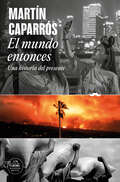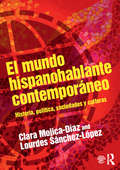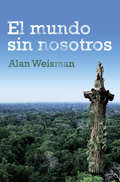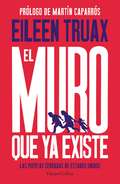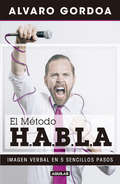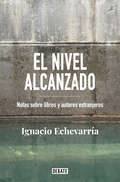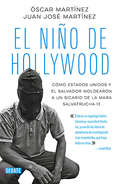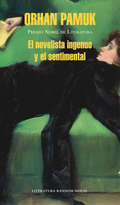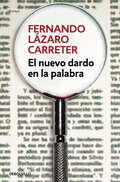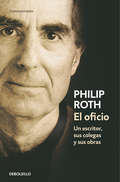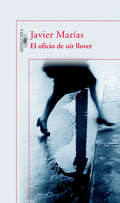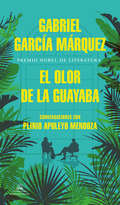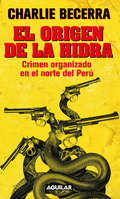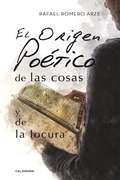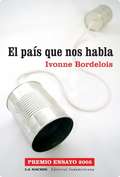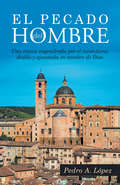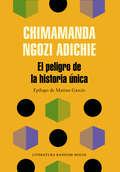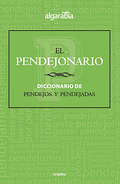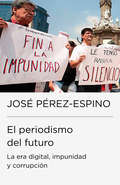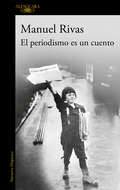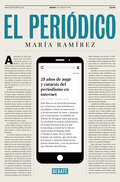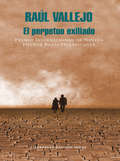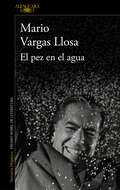- Table View
- List View
El mundo entonces
by Martín Caparrós*Premio Ortega y Gasset de Periodismo a la trayectoria profesional 2023* El mundo entonces es un fascinante retrato de nuestro presente, una herramienta que sirve para definir qué hacemos, quiénes somos, quiénes –quizá– seremos. «Martín Caparrós, uno de los más geniales cronistas contemporáneos, depura de manera exquisita, emocionada, vibrante y distanciada una prosa de un poderío narrativo excepcional». Fernando R. Lafuente, ABC Cultural El mundo entonces es una guía para entender el mundo en que vivimos. Escrito –propone Caparrós– por una historiadora del siglo XXII, resume y entrecruza los principales hilos conductores de nuestra organización social, económica, política y cultural para ofrecernos un panorama general de nuestra sociedad en el fin de la Era del Fuego. Sus capítulos incluyen desde la explosión demográfica hasta los cambios en el amor, la familia y la situación de las mujeres, pasando por las nuevas formas del trabajo, la irrupción de la IA, el poder de las grandes corporaciones digitales y su peso en nuestras vidas, el avance chino y el descrédito de las democracias, los cambios en el ocio y la alimentación, las nuevas formas de hacer la guerra y las viejas formas de creer en dioses. Todo contado de una forma sencilla y amena, enriquecida por análisis y datos que iluminan nuestra realidad con nuevos sentidos, miradas diferentes.Una primera aproximación a este proyecto fue publicada a lo largo de varios meses en El País. Este libro es su versión actualizada y aumentada con los perfiles de 25 personajes que definen nuestra época, desde Putin o Messi o Elisabeth Holmes hasta una pastora mongola o un príncipe de las islas Marshall o una obrera bengalí. Sobre el autor y su obra se ha dicho:«Un exquisito de la escritura y un lector omnívoro [...] Caparrós es una manera de ver y de entender el mundo».Carles Geli, Babelia «Caparrós es un maestro de la crónica».Juan Villoro, Reforma «Su prosa y su mirada son un reactivo fuerte para almas sensibles o amigas de lo políticamente correcto».Leila Guerriero, El País«El mejor cronista actual de América Latina: un soberbio entrevistador, un viajero dotado de cultura enciclopédica y de una fina ironía».Roberto Herrscher, La Vanguardia «El autor argentino despliega en Ñamérica el retrato coral de un continente marcadopor los tópicos literarios, el maniqueísmo histórico y la desigualdad económica».Andrea Aguilar, Babelia, El País «El conjunto es el resultado deun esfuerzo superheroico por contar y pensar de nuevo —y con nuevas ideas— medio continente».Jorge Carrión, La Vanguardia (sobre Ñamérica)
El mundo hispanohablante contemporáneo: Historia, política, sociedades y culturas
by Clara Mojica-Díaz Lourdes Sánchez-LópezEl mundo hispanohablante contemporáneo: historia, política, sociedades y culturas is a comprehensive and innovative book for advanced students of Spanish. Offering a constructivist approach to the study of the civilizations, cultures and histories of the contemporary Spanish-speaking world, the book focuses on learning as an active process that enables learners to develop high-level critical thinking skills through the exposure, research, examination and discussion of a variety of authentic films, songs and literary texts. Divided into twelve chapters, each chapter begins with an introduction to the general topic followed by various activities that lead students to critically analyse a range of authentic materials. Learners are able to practice higher level critical-thinking and linguistic skills through a wealth of tasks and exercises which culminate in a capstone section that requires the application of?the concepts learned and sources utilized throughout the lesson. El mundo hispanohablante contemporáneo: historia, política, sociedades y culturas offers great flexibility and adaptability to suit advanced courses in Hispanic culture and civilization. Each chapter is methodologically designed with a balanced mix of activities for individual and teamwork. Additional resources are available online for both instructors and students. These include an instructor’s guide with answer key, a grammar supplement and links to the authentic materials referenced within the book.
El mundo sin nosotros
by Alan WeismanAlan Weisman ha visitado los lugares clave del planeta y hablado con expertos de todo tipo para contestar a esta fascinante pregunta y explicarnos cómo nuestras enormes infraestructuras se hundirían y finalmente desaparecerían sin dejar rastro; cuánto tardarían las principales ciudades del planeta en reforestarse y las llanuras africanas en recuperar el esplendor de su fauna; por qué algunas de nuestras construcciones más antiguas podrían ser las últimas en desaparecer y cuáles de nuestros objetos quedarían inmortalizados como fósiles. Partículas de plástico indestructibles, gatos domésticos que se convierten en depredadores de éxito, plagas urbanas como las ratas o las cucarachas que desaparecen sin la presencia del hombre y estatuas de bronce que perviven milenios, son sólo algunos de los elementos que el lector se encontrará en este apasionante recorrido por un planeta tan familiar como extraño. Fascinante, agudo y profundamente inteligente: un enfoque original para tratar el impacto del ser humano sobre el planeta y la impresionante capacidad de regeneración de la naturaleza.
El muro que ya existe
by Eileen TruaxDurante décadas ha operado una máquina anti inmigratoria del gobierno estadounidense en connivencia con el mexicano, cometiendo violaciones a los derechos humanos e incumpliendo los estatutos internacionales para brindar refugio. En un país que empezó teniendo perseguidos políticos desde el salinismo, hasta el masivo desplazamiento forzada a causa de las políticas de seguridad del calderonismo, Eileen Truax, expone a través de un reporteo altamente contextualizado, las historias de quienes huyen de manera desesperada y sin encontrar el cobijo legal, económico y social de su país de origen, ni en el que históricamente se ha comprometido ante el mundo.
El método H.A.B.L.A: Imagen verbal en 5 sencillos pasos
by Álvaro GordoaAprende a comunicarte con los demás de manera asertiva y alcanza el éxito en tu vida. El Método H.A.B.L.A. te permitirá capacitarte directamente con el principal maestro y especialista en el tema de la Imagen Verbal ®. Hablar lo hace cualquiera. Penetrar en la mente del otro, necesita de un método. En este libro encontrarás un sencillo y divertido camino a seguir, con todas las claves para hablar en público y gozar de los beneficios de la comunicación de alto impacto. Con recomendaciones que podrás implementar de inmediato y sorprendentes revelaciones que desmitifican la dificultad de hablar en público. Figuras públicas opinan sobre este libro: "El saber hablar en público es de las habilidades que más admiro y Alvaro ha hecho de esto algo sencillo y divertido. De primera mano les garantizo que este método les cambiará la vida. A partir de hoy simplemente ¡H.A.B.L.A.!" -Martha Debayle, empresaria y comunicadora, reconocida como una de las mujeres más influyentes de Latinoamérica- "Hablar en público no es sólo para los políticos, hoy todos tenemos la necesidad de hacerlo bien y con claridad. Alvaro Gordoa, con El Método H.A.B.L.A., nos enseña cómo." -Fernando Lerdo de Tejada, ex vocero de la Presidencia de la República y experto en cabildeo y comunicación- "De El Método H.A.B.L.A. aprendí muchas cosas que uso diariamente en mi vida profesional. Alvaro te enseña a disfrutarlo tanto, que hablar en público pasa de ser una preocupación a una adicción." -Yordi Rosado, conductor, productor, conferencista y autor bestseller- "Con El Método H.A.B.L.A. los lectores entenderán muy fácilmente los principios de la oratoria y podrán enfrentar a un público y expresar sus ideas con claridad. Es un método que recomiendo ampliamente." -Antonio Asali, V.P. de Comunicación Verbal de la Asociación Mexicana de Consultores Políticos-
El método H.A.B.L.A: Imagen verbal en 5 sencillos pasos
by Álvaro GordoaAprende a comunicarte con los demás de manera asertiva y alcanza el éxito en tu vida. El Método H.A.B.L.A. te permitirá capacitarte directamente con el principal maestro y especialista en el tema de la Imagen Verbal ®. Hablar lo hace cualquiera. Penetrar en la mente del otro, necesita de un método. En este libro encontrarás un sencillo y divertido camino a seguir, con todas las claves para hablar en público y gozar de los beneficios de la comunicación de alto impacto. Con recomendaciones que podrás implementar de inmediato y sorprendentes revelaciones que desmitifican la dificultad de hablar en público. Figuras públicas opinan sobre este libro: "El saber hablar en público es de las habilidades que más admiro y Alvaro ha hecho de esto algo sencillo y divertido. De primera mano les garantizo que este método les cambiará la vida. A partir de hoy simplemente ¡H.A.B.L.A.!" -Martha Debayle, empresaria y comunicadora, reconocida como una de las mujeres más influyentes de Latinoamérica- "Hablar en público no es sólo para los políticos, hoy todos tenemos la necesidad de hacerlo bien y con claridad. Alvaro Gordoa, con El Método H.A.B.L.A., nos enseña cómo." -Fernando Lerdo de Tejada, ex vocero de la Presidencia de la República y experto en cabildeo y comunicación- "De El Método H.A.B.L.A. aprendí muchas cosas que uso diariamente en mi vida profesional. Alvaro te enseña a disfrutarlo tanto, que hablar en público pasa de ser una preocupación a una adicción." -Yordi Rosado, conductor, productor, conferencista y autor bestseller- "Con El Método H.A.B.L.A. los lectores entenderán muy fácilmente los principios de la oratoria y podrán enfrentar a un público y expresar sus ideas con claridad. Es un método que recomiendo ampliamente." -Antonio Asali, V.P. de Comunicación Verbal de la Asociación Mexicana de Consultores Políticos-
El nivel alcanzado: Notas sobre libros y autores extranjeros
by Ignacio EchevarríaUn recorrido por la obra de los grandes autores de la literatura occidental de la mano del crítico más riguroso y polémico de nuestro país. Este volumen recoge una selección de reseñas, artículos, conferencias y prólogos sobre libros y autores «extranjeros» escritos en el transcurso de tres décadas. El conjunto da cuenta de una gran diversidad de intereses, que se proyectan en diferentes épocas, tradiciones y géneros. De Lawrence Sterne a V.S. Naipaul, pasando por Stendhal, Musil, Kipling, Malraux, Gombrowicz, Canetti o Iris Murdoch; de William Hazlitt a George Steiner, pasando por Walter Benjamin o Raymond Williams, los nombres aquí reunidos son otros tantos hitos de la particular cartografía que Ignacio Echevarría ha ido configurando como lector conforme desarrollaba su actividad como crítico y editor. Decía Robert Musil que la crítica es «una interpretación de la literatura que se traspone en interpretación de la vida, yuna celosa custodia del nivel alcanzado». De estas palabras se desprende el título de este volumen, del que Andreu Jaume, responsable de la edición, dice en su prólogo que «es mucho más que una simple recopilación de reseñas y ensayos sobre autores y obras en lenguas extranjeras. Su contenido puede analizarse a la luz de lo que fue la lectura paralela que Ignacio Echevarría hizo en su día de la literatura española publicada desde la Transición. La constelación de autores que aquí se reúne no es tanto un canon personal como un compromiso de ambición a la vez moral, política y estética». Cromos Mariposas amarillas Imaginar el mundo Una habitación compartida
El niño de Hollywood
by Óscar Martínez Juan José MartínezCómo Estados Unidos y El Salvador moldearon a un sicario de la Mara Salvatrucha 13 ¿Qué tiene que ver la administración Reagan con que un pandillero centroamericano haya asesinado a más de 50 personas en su país? ¿Qué relación hay entre la ciudad de Los Ángeles de los años 70 y el violento occidente salvadoreño del nuevo siglo? ¿Cómo un grupo de migrantes adictos al heavy metal terminó pariendo a la pandilla más reconocida del mundo? ¿Es una tontería explicar un genocidio indígena, los procesos del café en El Salvador y la guerra civil de 12 años para entender a un asesino de la Mara Salvatrucha 13? ¿Cómo puede un Estado como el salvadoreño quedar en deuda con un despiadado sicario? Hay muchas preguntas y muchas respuestas. Una de ellas es ésta, la vida de Miguel Ángel Tobar, El Niño de la clica Hollywood Locos Salvatrucha de la MS-13. Incluso hay preguntas que quedan abiertas: ¿cómo es posible que, décadas después, el gobierno estadunidense encabezado por Donald Trump no haya entendido nada de esto?
El novelista ingenuo y el sentimental
by Orhan PamukEn 2009, el Premio Nobel de Literatura Orhan Pamuk estuvo a cargo del seminario Charles Eliot Norton en la Universidad de Harvard. Este libro reúne las seis conferencias que escribió para tal ocasión. ¿Qué pasa en nuestro interior cuando leemos una novela? ¿Cómo puede una novela crear ese efecto único, tan distinto del producido por la pintura, el cine o la poesía? En este libro inspirador y sumamente personal, Pamuk nos lleva de la mano a los mundos del escritor y del lector, poniendo de manifiesto las íntimas conexiones entre ambos. Pamuk recurre a la famosa distinción de Friedrich Schiller entre poetas «ingenuos» (los que escriben con espontaneidad, serenidad y naturalidad) y poetas «sentimentales» (reflexivos, emotivos, inquisidores y sensibles al artificio de la palabra escrita). Remontándose a las novelas de su adolescencia y deteniéndose en las obras de Tolstói, Dostoievski, Stendhal, Flaubert, Proust, Mann y Naipaul, Pamuk explora la oscilación entre lo ingenuo y lo reflexivo, así como la búsqueda del equilibrio que se encuentra en el corazón mismo del oficio de todo novelista. Cualquiera que haya tenido el placer de sumergirse en una novela disfrutará y aprenderá de esta intensa obra de Orhan Pamuk.
El nuevo dardo en la palabra
by Fernando Lázaro CarreterLa acogida excepcional que, hace cinco años, obtuvo la compilación de los artículos aparecidos con el título El dardoen la palabra ha llevado a Fernando Lázaro Carreter a reunir en este volumen los publicados desde 1999 en el diario El País.Con erudición y agudo sentido del humor, el eminente académico alerta acerca del desconocimiento de los recursos del propio idioma, tan recuente en cuantos gozan de vida pública, y el aluvión acrítico de términos nuevos innecesarios, que hacen peligrar la comunicación entre millones de hispanohablantes. Procurar la estabilidad del español es una labor que corresponde a todos los hablantes con una conciencia crítica. A ellos van destinados estos «dardos». Reseña:«Los dardos no están hechos para multar ni para encarcelar a nadie, soloquierenser unallamadade atención para no desviarse del camino que la comunidad lingüística nos traza. Una excelente llamada.»El Cultural
El oficio
by Philip RothUna conversación en Turín con Primo Levi. Otra en Jerusalén con Aarón Applefeld. Otra en Praga con Ivan Kílma. Dos con Milan Kundera en Conneticut y Londres. Un encuentro con Isaac Bashevis Singer en Nueva York para hablar sobre Bruno Schulz. Un viaje a Londres para charlar con Edna OBrien. Dos retratos: Bernard Malamud y Philip Guston. Y una relectura: Saul Bellow. Todo esto compone El oficio: un escritor, sus colegas y sus obras (2001), un libro en el que Roth reflexiona, acompañado por grandes figuras de la literatura, sobre la religión, la política, la sexualidad, la supervivencia, el exilio... Sobre cómo sus vidas se asoman a su literatura. Sobre cómo su literatura recibe la influencia de la sociedad en la que viven. El lector asistirá a través de sus páginas a una lección magistral de uno de los escritores más relevantes de la literatura actual.«Roth se las arregla para sacar de sus interlocutores las convicciones que alimentan sus obras y las vulnerabilidades que los hacen humanos... Una muestra más de la claridad de su proyecto y su singular inteligencia.»The New York Times Book Review
El oficio de oír llover
by Javier MaríasEste volumen recoge noventa y nueve artículos publicados entre febrero de 2003 y febrero de 2005, es decir, los dos primeros años de colaboración de Javier Marías en El País Semanal. En este casi centenar de piezas, Marías se muestra tan combativo e irreverente como de costumbre, y lo hace cuando era más oportuno: durante una etapa de nuestra historia algo sombría, que tuvo su máxima expresión trágica en los atentados madrileños del 11 de marzo de 2004. A los columnistas, dice Marías, «hay temporadas en que la realidad se nos impone en exceso, y hasta nos parece inmoral no referirnos a los acontecimientos graves en que nos hallamos inmersos todos». Sin embargo, la variedad de asuntos tratados, casi siempre con leve nostalgia o con aguda ironía, es considerable: desde evocaciones de su madre muerta y de su padre anciano, del amigo de infancia o de las viejas colecciones de cromos de futbolistas, hasta las creencias y costumbres más necias de nuestro tiempo, la búsqueda de tumbas legendarias durante algunos viajes o la cada vez menos importancia de lo dicho y de las palabras, que lleva a demasiadas personas, sobre todo a los políticos, a ejercer constantemente «el oficio de oír llover». Por suerte, existen aún escritores que, como Javier Marías, no se limitan a eso, sino que, con sus palabras, «intentan distinguir algo en medio del rumor manso o del ruido atronador de los acontecimientos».
El oficio: Un escritor, sus colegas y sus obras
by Philip RothLa historia, la religión, el impulso creador. Un gran escritor y sus diálogos con grandes escritores. Una conversación en Turín con Primo Levi. Otra en Jerusalén con Aarón Applefeld. Otra en Praga con Ivan Kílma. Dos con Milan Kundera en Conneticut y Londres. Un encuentro con Isaac Bashevis Singer en Nueva York para hablar sobre Bruno Schulz. Un viaje a Londres para charlar con Edna O'Brien. Dos retratos: Bernard Malamud y Philip Guston. Y una relectura: Saul Bellow. Todo esto compone El oficio: un escritor, sus colegas y sus obras (2001), un libro en el que Roth reflexiona, acompañado por grandes figuras de la literatura, sobre la religión, la política, la sexualidad, la supervivencia, el exilio... Sobre cómo sus vidas se asoman a su literatura. Sobre cómo su literatura recibe la influencia de la sociedad en la que viven. El lector asistirá a través de sus páginas a una lección magistral de uno de los escritores más relevantes de la literatura actual. Reseña:«Roth se las arregla para sacar de sus interlocutores las convicciones que alimentan sus obras y las vulnerabilidades que los hacen humanos... Una muestra más de la claridad de su proyecto y su singular inteligencia.»The New York Times Book Review
El olor de la guayaba
by Plinio Apuleyo Mendoza Gabriel García MárquezEn El olor de la guayaba pueden encontrarse las claves de un proceso creador y creativo de singular riqueza. Si formalmente El olor de la guayaba es una prolongada conversación del escritor y periodista Plinio Apuleyo Mendoza con su viejo amigo Gabriel García Márquez -lo que da ocasión a éste para desgranar con vivacidad sus remembranzas, juicios, opiniones y convicciones- sus contenidos van mucho más allá: en El olor de la guayaba bien pueden encontrarse las claves de un proceso, creador y creativo, de singular riqueza. De la mano de Mendoza, García Márquez desvela el mundo que refleja su obra -hasta transfigurarlo- con la magia de la palabra: la calidez y el color del Caribe, el universo mítico de sus pobladores, la extraña mentalidad de sus extraños prohombres y caudillos. Una obra en la que el compromiso con la emoción y el compromiso con la razón se dan la mano, para ofrecer la más sugerente aproximación a un ser que de puro complejo puede permitirse el lujo de ser nítido.
El origen de la hidra
by Charlie BecerraEsta es la historia del crimen organizado en el norte del Perú como nunca antes se había contado. No es tierra de nadie la que parece tener muchos dueños. Tras años de investigación, Charlie Becerra desentraña los mecanismos del crimen organizado en el norte peruano, que como la hidra, monstruo mitológico, multiplica sus fauces hambrientas de poder. Este libro es un viaje a través de distintas ciudades del norte -Trujillo, Chiclayo, Chepén-, de las historias de peligrosos criminales que han intentado apoderarse de ellas y de quienes se han atrevido a combatirlos. Este libro habla de asesinos como el Viejo Paco y de mafias como La Gran Cruz de Piura y sus vínculos con la política y la Iglesia. De fiscales valientes que van a la caza de bandas delincuenciales. De escuadrones de la muerte y de policías que cruzan la línea de la ley. De madres y padres que buscan justicia para sus hijos desaparecidos. Todo esto a la sombra de gigantescos cargamentos de droga y montañas de dinero sucio.
El origen poético de las cosas y de la locura
by Rafael Romero ArzeEl loco es el nuevo y moderno súper hombre, donde entiende la necesidad de la vida, y clama una muerte poética. Este libro elogia a la locura y la propone como una corriente para descondicionar el contenido del cerebro. <P><P>Es una osadía y audacia poética para este mundo de aspiraciones colectivas, consumistas, plásticas y racionalistas. Considera a la locura como un paso previo para vaciar el contenido de la conciencia. <P><P>En el libro todo comienza con el origen y la simbología lingüística de las cosas, la cosa tiene existencia y trasciende en la vida material y en la espiritual de los hombres. <P>Es el hombre loco el que debe reinar el mundo de la vida y la muerte. El hombre loco es la única persona que le da sentido a su propia existencia.
El país que nos habla
by Ivonne BordeloisUn lúcido y profundo trabajo de investigación sobre la manera de hablarde los argentinos. La autora, Ivonne Bordelois, describe con impecable rigor metodológico ycon admirable capacidad de observación social los avatares que ha idosufriendo, a través del tiempo, el lenguaje de los argentinos, sometidoa las influencias de los frecuentes cambios que sufrió la población delpaís como resultado de los grandes procesos inmigratorios, de lassucesivas transformaciones socioculturales y, más recientemente, de loshábitos incorporados por los avances de la informática.Acosados por una crisis política y social que nos ha despojado de casitodo, es importante que los argentinos nos preguntemos si lo hemosperdido todo o si hay algo que todavía nos queda. De eso trata,justamente, el ensayo de Ivonne Bordelois, de la naturaleza inalienabledel lenguaje, que es el gran recurso que nos ha dejado la historia.
El pecado del hombre: Una trama engendrada por el mismísimo diablo y ejecutada en nombre de Dios
by Pedro A. LópezUna trama engendrada por el mismísimo diablo y ejecutada en nombre de Dios. <p><p>No había más mundo para Jonás que el agradecimiento y entrega a quien le había sacado de la mísera e incierta vida callejera cuando apenas empezó a tener uso de razón. Tal fue su gratitud que no dudó ni un segundo en hacer aquello que mejor sabía cuando fue requerido para ello, matar, de la forma más atroz conocida por el hombre, crucificando a sus víctimas. <p> A lo largo de toda la trama, el asesino será buscado y perseguido por un grupo de investigadores encabezado y dirigido por el agente Sauwer Dalton perteneciente a la Oficina Federal de Investigación de los Estados Unidos, los cuales llevarán a cabo un exhaustivo e impecable trabajo con el único objetivo de cazar al cazador. <p>Crímenes, odios, engaños, traiciones y una inexpugnable red de corrupción al más alto nivel, e incluso una historia de amor en medio del infierno, conforman una trepidante trama que conseguirá que el lector que decida sumergirse en ella, disfrute de un trailer sin precedentes, sobre el más sanguinario asesino en serie del siglo XX.
El peligro de la historia única
by Chimamanda Ngozi AdichieLa TED talk más popular de Chimamanda, con más de doce millones de reproducciones. «Las historias importan. Importan muchas historias. Las historias se han utilizado para desposeer y calumniar, pero también pueden usarse para facultar y humanizar. Pueden quebrar la dignidad de un pueblo, pero también pueden restaurarla.» Con su característico amor por las historias, en este manifiesto Chimamanda Ngozi Adichie hace una llamada a rechazar los relatos únicos. Se trata de su primera TED Talk, un emotivo discurso que han visto más de tres millones de personas. Con rotundidad y calidez, la autora reivindica la riqueza de la infinitud de historias que nos conforman. En este texto -que se cierra con una reflexión de la filósofa Marina Garcés- Ngozi Adichie alerta sobre los peligros de reducir una persona, un país o una cultura a un relato unívoco, pues solo cuando comprendemos que nunca existe una única historia, subraya, recuperamos una especie de paraíso. Críticas:«Un discurso fabuloso.»The New York Times «Adichie (tiene) virtuosismo, empatía sin límites y una punzante agudeza social.»Dave Eggers «He aquí una nueva escritora dotada con la habilidad de los antiguos contadores de historias.»Chinua Achebe «Una escritora que tiene mucho que decir.» The Times «Adichie está dando forma a la historia de su país. Es afortunada y nosotros, sus lectores, lo somos aún más.»Edmund White
El pendejonario: Diccionario de pendejos y pendejadas
by María del Montes de OcaDiviértase y deje de hacerse pendejo, o hágalo, pero mientras lee El pendejonario. En El pendejonario encontrará: - Tipologías: descubra a cuál pendejo pertenece, puede ser que se identifique con más de dos. - Sobre lo pendejo y sus derivados: la pendejez está adherida al habla hispana, vea los usos de este calificativo y sus derivados en Latinoamérica. - Horóscopos: su pendejez no es gratuita, sino producto de la posición relativa de los planetas el día en que usted nació. - Frases de gente famosa: ni siquiera Borges, Sócrates o Einstein se salvan de la maldición pendeja, por eso la expresan en sus pendefrases. - Expresiones populares: reflejan alguna situación sobre la pendeja vida. - Canciones y citas literarias pendejas: porque la pendejez no queda fuera de las manifestaciones artísticas. En Algarabía editorial hablamos sobre lo que todos hablan y escribimos de lo que nadie escribe, pero tratado de un modo inteligente, claro y humorístico. Por esta razón, Algarabía, en coordinación con el doctor Justo Muñoz, decidió dedicar este libro a uno de los adjetivos coloquiales que unifican a la humanidad: pendejo. La base para estructurar un proyecto como El pendejonario fue la iniciativa del Partido Autónomo de Pendejos (PAP), que retomó la idea original de don Hermenegildo L. Torres, quien creó la fundación Pro Unificación del Pendejo (PUP), en donde se desarrolló toda una corriente humorística, expuesta tanto en conferencias como en charlas: "tarea de verdadero proselitismo", como el mismo Hermenegildo determinó. El objetivo primordial del PAP es enriquecer el glosario del calificativo pendejo por medio de las aportaciones voluntarias y creativas de todos aquellos que decidan pertenecer a su membresía; así como llevar a cabo diferentes conferencias y charlas referentes al tema, con la finalidad de ampliar el corpus de dicho término en sus diferentes formas y contextos.
El periodismo del futuro: La era digital, impunidad y corrupcción
by José Pérez-Espino"La afirmación de que las redes sociales representan una amenaza para el periodismo se convirtió en un axioma mediático. Es una frase muy llamativa, pero falsa." José Pérez-Espino Los nuevos formatos de presentación y consumo de contenidos informativos han obligado a los periodistas a buscar una reinvención permanente. En cualquier caso, asegura José Pérez-Espino, sobrevivirán los medios que apuesten por la investigación para dar sentido a la pluralidad, siempre que usen las herramientas digitales disponibles bajo principios éticos y de compromiso con sus lectores. Sin embargo, la tecnología y las redes sociales no representan una amenaza real para el periodismo: las verdaderas amenazas son la impunidad y la indolencia en las agresiones y los asesinatos de comunicadores. En tal contexto, asegura José Pérez-Espino, resulta fundamental exigir a las autoridades investigaciones puntuales para aclarar los crímenes y hacer justicia. Sin duda, estamos ante un reportaje contundente y de gran actualidad que aborda los elementos necesarios para emprender una urgente reflexión acerca del futuro de ese oficio de alto riesgo llamado periodismo.
El periodismo es un cuento
by Manuel RivasEdición revisada y ampliada de un libro magistral formado por cuentos verídicos. El gran periodismo como obra literaria. El periodismo es un cuento recoge gran parte de los reportajes escritos a lo largo de los años por Manuel Rivas. Son historias que nacieron en la prensa, pero que tienen vocación de relatos para ser contados al calor de la lumbre como leyendas labradas por el tiempo. Sus héroes son una niña autista, un grupo de mujeres hindúes, una mujer exiliada en México, las víctimas del conflicto armado colombiano, una tripulación de pescadores en el Gran Sol... Periodismo y literatura se dan la mano en este libro con la ironía y la sensibilidad que caracteriza toda la obra de Rivas, quien afirma en el prólogo a esta edición: «El periodismo, tal como lo entiendo, es un modo de activismo. Es un periodismo que lucha contra la indiferencia y la banalidad. Un activismo consistente en custodiar el sentido de las palabras. En intentar decir "lo que no se puede decir". En mirar "lo que no se puede ver". Mover el silencio. Ante las injusticias provocadas, que pretenden presentarse como un shock inevitable, indagar sobre la causalidad de los hechos. Es el lenguaje, como pedía Albert Camus, que no quiere dominar. Es el lenguaje del porqué.» La crítica ha dicho sobre el autor y su obra...«Un autor que sabe cómo introducir la poesía no sólo en sus frases, sino también en su manera de ver el mundo.»Raphaëlle Rérolle, Le Monde «Manuel Rivas es un clásico indiscutible.»The Scotsman «Manuel Rivas demuestra tener un gran sentido de la historia.»John Berger, Minerva «Rivas desvela el alma de los espacios, lo que guardan o contienen en tanto que expresión de emblema del carácter de un pueblo.»Ana Rodríguez Fischer, Babelia «He aprendido más de la Guerra Civil española leyendo El lápiz del carpintero, de ManuelRivas, que en todos los libros de historia.»Günter Grass «Los libros arden mal es una novela excepcional escrita por un autor excepcional.»The Independent «Un auténtico tour-de-force narrativo [...]. Rivas nunca pierde la fe en la capacidad humana para superar la más sombría de las situaciones.»The Irish Times (sobre Todo es silencio) «Cada año descubro un par de buenos libros. Uno de mis últimos descubrimientos es El lápiz del carpintero, de Manuel Rivas.»Erri de Luca, Babelia «Azcona me habló de Qué me quieres, amor. Lo compré y lo leí. A partir de ese momento no paré hasta que conseguí, pantagruélicamente, engullir, paladear todos los libros que, hasta la fecha, había publicado Rivas. Y sorberles los tuétanos.»José Luis Cuerda, El Cultural
El periódico: 25 años de auge y catarsis del periodismo en Internet
by María RamírezLa historia de España a través de su prensa. Un ensayo nostálgico y sin embargo optimista. ¿Por qué este libro?Los últimos veinticinco años han sido tal vez los más agitados para la historia de los periódicos en lo que se refiere a la revolución de las herramientas y el impacto global de lo que hacemos. En un momento como este, de ebullición de la información y también de confusión sobre qué es el periodismo, tenía especial interés en mirar atrás y contar, a través de mi experiencia personal, la vida de redacciones entre ilusiones, desilusiones y la energía infinita que siempre nos dan las noticias. Defina la situación de la prensa en una frase.La prensa siempre está en busca de un camino y lo encuentra más a menudo de lo que parece. ¿Puede sobrevivir el periódico en la era de internet?El periódico ha cambiado y se enfrenta continuamente a nuevos dilemas. Cada vez está más claro que su modelo de negocio solo es verdaderamente lucrativo para unos pocos medios en el mundo. Pero no solo ha sobrevivido a internet, sino que en muchos casos ha florecido en su era. La prueba de ello es la cobertura de las turbulencias de los últimos años, desde la victoria de Donald Trump y el Brexit hasta la pandemia y la invasión rusa de Ucrania. ¿Qué nos enseña la revolución digital en Estados Unidos?La lección es que la grandeza de los periódicos está en sus redacciones, su misión y su trabajo más básico que cosecha éxitos cuando los recursos y las prioridades están en el corazón de la información. Les costó, pero al final los triunfadores de la nueva era del periodismo en internet han sido el New York Times, el Washington Post o incluso el Boston Globe, y no tanto Buzzfeed, Vox Media y otras startups que supuestamente iban a reinventar el modelo de negocio porque los periodistas no éramos capaces de hacerlo. ¿La prensa española ha estado a la altura de la revolución de internet?Como sugieren varias personas entrevistadas en este libro, a menudo los gestores de las empresas llegaron tarde, gastaron demasiado donde no debían o confiaron en falsos gurús, pero esto ha contrastado a menudo con el empuje y la capacidad de reinvención de los periodistas. No es casualidad que España sea uno de los pocos países europeos donde hay un número significativo de medios influyentes y rentables que han nacido en internet.
El perpetuo exiliado
by Raúl VallejoNovela ganadora del Premio Héctor Rojas Herazo La figura de José María Velasco Ibarra se ha ido difuminando en la leyenda. De su vida y su proyecto político se recuerda poco, salvo el hecho -impresionante, sí- de que arribó cinco veces a la presidencia del Ecuador y de que el destino de esta gloria fue siempre el destierro. Contra esta fácil simplificación se erige El perpetuo exiliado, novela en la que reaparece el político de carne y hueso, idealista y represor, portavoz de los anhelos de su pueblo y facilitador del poder oligárquico, así como el romántico enamorado de la poeta argentina Corina Parral, la mujer que lo acompañó en sus exilios.El jurado del Premio Internacional de Novela Héctor Rojas Herazo dijo, al premiar esta obra, que se está galardonando la fuerza de su argumento y su extraordinaria investigación, toda vez que ella en sí es un tratado de literatura y geopolítica. En la escritura de esta novela collage está imbricada una historia de amor en cuarenta años de historia política del Ecuador, pero el Velasco Ibarra de estas páginas, como señala el autor, no pertenece tanto a la historia como a la literatura.
El pez en el agua
by Mario Vargas LlosaUn libro cargado de experiencias que se nos muestran desnudas y sinceras, sin recurrir a la ficción, acompañadas tan sólo de la prosa hipnótica, reveladora y magistral de Mario Vargas Llosa. El pez en el agua recorre dos épocas en la vida de Mario Vargas Llosa que enmarcan buen parte de su producción literaria. En la primera, desde sus primeros años hasta su partida a Europa, asistimos al nacimiento de una vocación literaria y descubrimos muchas de aquellas vivencias que serán el mimbre de tantas novelas. La segunda es la crónica de la aventura política en la que el autor se embarcó entre los años 1987 y 1990, cuando se presentó como candidato a las elecciones presidenciales del Perú. Reseña:«Hay que leer El pez en el agua, un libro capital en su bibliografía en el que está la sustancia de lo que dice el jurado que le concede el Nobel: el Vargas Llosa que mira al poder desde dentro o desde sus orillas, y el que sigue maravillado y aterrado ante algunos de los elementos más sobresalientes de su niñez y de su juventud.»Juan Cruz, El País
